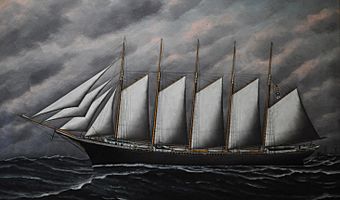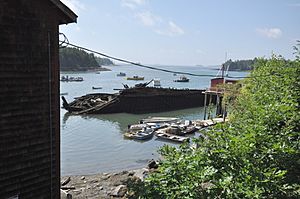Cora F. Cressey facts for kids
Quick facts for kids |
|
|
Cora F. Cressey
|
|

Painting of the Cora F. Cressey by Solon Badger
|
|
| Location | Keene Narrows, Bremen, Maine |
|---|---|
| Area | 0.1 acres (0.040 ha) |
| Built | 1902 |
| Architect | Percy and Small Shipyard |
| NRHP reference No. | 90000586 |
| Added to NRHP | April 18, 1990 |
The Cora F. Cressey was a huge wooden ship with five masts. She was a type of sailing ship called a schooner. Built in 1902, she carried goods like coal along the eastern coast of the United States. After her sailing days, she became a floating nightclub! Later, her old hull was moved to Bremen, Maine. There, she was sunk on purpose to act as a barrier, protecting a lobster farm. Even though she's old and falling apart, her hull is one of the biggest wooden ship parts still left in the U.S.
Contents
Building a Giant Schooner
The Cora F. Cressey was built in 1902. She was made at the Percy and Small Shipyard in Bath, Maine. This shipyard is now part of the Maine Maritime Museum.
Her Size and Design
When she was new, the Cora F. Cressey was a five-masted schooner. She was about 273 feet (83 m) long. That's longer than a football field! Her width was about 45.4 feet (13.8 m). The inside of her hull was about 27.9 feet (8.5 m) deep.
Her hull was made of wood. It had strong iron bands to make it even tougher. She could carry a lot of cargo. Her crew usually had eleven people. She also had a small steam engine. This engine was only for lifting anchors and sails. It did not help her move through the water.
Life at Sea and Beyond
The Cora F. Cressey spent most of her life carrying coal. She sailed up and down the eastern coast of the United States. She would pick up coal in the south and deliver it to northern cities.
Surviving a Storm
In 1924, a terrible storm hit. The Cora F. Cressey survived it! Her tall front end, called a bow, helped her get through the rough waves. Sadly, another very large schooner, the Wyoming, sank in that same storm.
From Ship to Nightclub
The Cora F. Cressey stopped sailing in 1928. In 1929, she got a new job. She was turned into a floating nightclub in Boston. Later, she was moved to Gloucester, Massachusetts and Providence, Rhode Island for the same purpose.
Becoming a Breakwater
In 1938, her tall masts were taken down. A person who owned a lobster business in Bremen, Maine bought her. She was pulled to a place called Keene Narrows. This spot is between the mainland and Oar Island.
She was partly filled with sand. The idea was for her to become a lobster pound. This meant a place to keep lobsters. Holes were cut in her hull to help water flow. But this didn't work as planned. Instead, she became a "breakwater." A breakwater is like a wall that protects smaller boats or structures from strong waves. She protected the lobster pens that were set up between her and the shore.
Over time, the old ship started to fall apart. In 1988, a 40-foot (12 m) piece of her hull broke off. Some of her original parts were taken off before she became a breakwater. These parts are now on display at the Maine Maritime Museum.
Why She's Important Today
The old, decaying hull of the Cora F. Cressey is very special. It is one of the biggest wooden ship hulls still existing in the United States.
Challenges of Big Wooden Ships
Building very large ships out of wood was hard. These ships often leaked. They also struggled in bad weather. Steam-powered ships became more popular. They could travel more reliably than sailing ships. Even though some wooden schooners had up to seven masts, they couldn't compete with steam power. Today, there are no known surviving wooden hulls of six- or seven-masted schooners.




